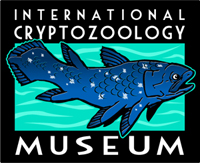Coelacanth #5 Taken In Asia
Posted by: Loren Coleman on October 6th, 2009
John Yeld, Environment and Science Writer, is reporting that the fifth specimen of an Asian species of the coelacanth (Latimeria menadoensis), discovered in 1997-1998, was recently captured alive off Indonesia.
“A local newspaper reported that the specimen, which measured 114cm, was caught on September 16 and collected by a scientist from Indonesia’s Sam Ratulangi University for further examination. It died on the way to the university.
“Two days previously, Indonesian marine scientists and officials from an aquarium in Japan had photographed another coelacanth in nearby waters – their second sighting in two years in this region.
South African scientist and coelacanth expert Professor Mike Bruton expressed “concern about the involvement of the aquarium team, saying he and other scientists believed that they were trying to capture a live specimen for display in Japan.”
Coelacanths are listed under Appendix 1 of Cites (Convention on the International Trade in Endangered Species) and no commercial trade of any kind is permitted for such species.
The better known and more comprehensively studied coelacanth species is Latimeria chalumnae, which has been found in waters off the Comoros, Kenya, Tanzania, Mozambique, Madagascar and Sodwana Bay, KwaZulu-Natal.
Belgian researcher Rik Nulens has recorded in his database 285 individuals of this species caught since 1938: one each from South Africa, Mozambique and Kenya; eight from Madagascar; 59 from Tanzania; and the rest – 215 – from the Comoros.
Original information noted here was first published on page 11 of Cape Argus on September 23, 2009, and just made it to my attention.
Please positively assist the move of the International Cryptozoology Museum, as it soon opens in downtown Portland, Maine. Please click on the button below (not the one up top) to take you to PayPal to send in your museum donation.
If you wish to send in your donation via the mails, by way of an international money order or, for the USA, via a check (made out to “International Cryptozoology Museum”) or money order, please use this snail mail address:
Loren Coleman, Director
International Cryptozoology Museum
PO Box 360
Portland, ME 04112
Thank you, and come visit the museum at 661 Congress Street, Portland, Maine 04101, beginning November 1, 2009!!
Not a 501(c)3, so your donations are all that more important, whether $15, $25, or $150!!
About Loren Coleman
Loren Coleman is one of the world’s leading cryptozoologists, some say “the” leading living cryptozoologist. Certainly, he is acknowledged as the current living American researcher and writer who has most popularized cryptozoology in the late 20th and early 21st centuries.
Starting his fieldwork and investigations in 1960, after traveling and trekking extensively in pursuit of cryptozoological mysteries, Coleman began writing to share his experiences in 1969. An honorary member of Ivan T. Sanderson’s Society for the Investigation of the Unexplained in the 1970s, Coleman has been bestowed with similar honorary memberships of the North Idaho College Cryptozoology Club in 1983, and in subsequent years, that of the British Columbia Scientific Cryptozoology Club, CryptoSafari International, and other international organizations. He was also a Life Member and Benefactor of the International Society of Cryptozoology (now-defunct).
Loren Coleman’s daily blog, as a member of the Cryptomundo Team, served as an ongoing avenue of communication for the ever-growing body of cryptozoo news from 2005 through 2013. He returned as an infrequent contributor beginning Halloween week of 2015.
Coleman is the founder in 2003, and current director of the International Cryptozoology Museum in Portland, Maine.











Collecting a specimen for display at an aquarium might not be against the CITES convention provided the aquarium is part of a scientific research/educational function. On the presumption that it is, it would be interesting to see one of these creatures alive and learn something about that which makes every living creature interesting.
It’s pretty clear that while not common enough to sustain a commercial harvest, even one dedicated to curiousity seekers and souvenier takers, it’s protection is a good thing but aquariums bring an appreciation for healthy oceans into the lives of people whom otherwise may not realize the ocean’s health have significance to the rest of the planet’s living web.
Considering how many places the coelecanth has been found so far, and how unexamined are the depths in which they flourish, I won’t be surprised if a wider range than we conservatively anticipate now is one day recognized.
I happen to agree with Dogu4.
I don’t quite see anything wrong with this as long as it is for scientific inquiry.
I would love to see one alive.
I totally cool with one alive on public display.
I have to say that if anyone is going to pull off the keeping of a live coelacanth, it is the Japanese. Some of the most sophisticated and advanced aquariums in the world are to be found here in Japan, and the drive towards research and development in aquarium science is cutting edge.
Some difficult species to keep in captivity, such as the whale shark have been successfully kept for long periods of time in Japan, and it is due to some surprising innovations made by the Japanese.
Although so little is known about these fish that there are some concerns, I would say a coelacanth would likely be in good hands here. I’m all for a captive specimen if it is for study and raising public awareness of these wonderful creatures.